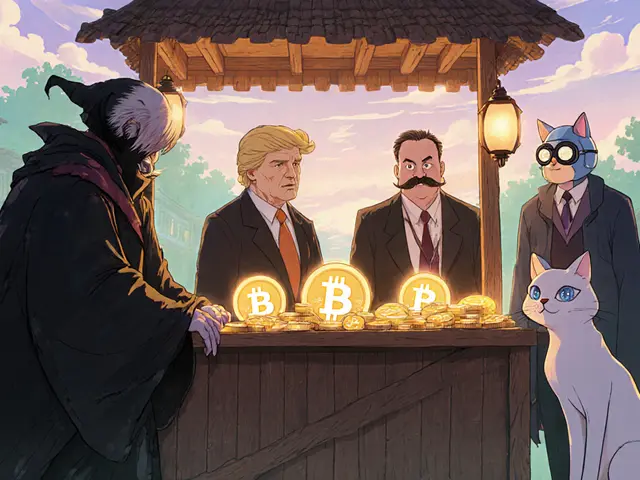1
What is Bitgert (BRISE) crypto coin? Full breakdown of the blockchain, tokenomics, and real-world performance

BRISE Token Value Calculator
BRISE Investment Value Calculator
Calculate the current value of your BRISE tokens, potential future value, and staking rewards. This tool uses the information from the article to give you realistic scenarios.
Bitgert (BRISE) isn’t just another crypto coin. It’s a blockchain project that promises something almost unheard of: zero gas fees and 100,000 transactions per second. That’s not a typo. For comparison, Ethereum handles about 15-30 TPS. Binance Smart Chain manages around 200. Bitgert claims to blow both out of the water. But does it deliver? Or is it all hype wrapped in a whitepaper?
What exactly is Bitgert?
Bitgert started life as Bitrise in mid-2021, then quietly rebranded to Bitgert without changing the BRISE token. The team behind it remains anonymous - no LinkedIn profiles, no public founders, no press tours. That’s not unusual in crypto, but it does raise questions. What you get instead is a long list of products: a blockchain called Bitgert Chain (or Brise Chain), a decentralized exchange (SPYNX Labs), a payment app (Paybrise), an NFT marketplace, and even a real estate platform. The goal? To build one giant Web3 ecosystem where everything runs on BRISE.
The BRISE token is the engine. It’s used to pay for transactions, stake for rewards, buy NFTs, and trade on their exchange. It exists on two chains: Binance Smart Chain (BEP-20) and Ethereum (ERC-20). But here’s the twist - the tokenomics are different on each. On BSC, every buy triggers a 5% fee that goes into a buyback pool, 3% to marketing, and 4% to staking rewards. On Ethereum, there are no fees at all. That’s not a mistake. It’s a design choice meant to lure users away from high-cost networks.
The Bitgert Chain: Zero fees and 100K TPS - real or just numbers?
The heart of Bitgert’s pitch is its own blockchain: the Brise Chain. It claims to process 100,000 transactions per second with a gas fee of $0.0000000000001. That’s one ten-trillionth of a dollar. For context, sending $10 on Ethereum might cost you $5 in gas. On Bitgert? You’d pay less than a billionth of a cent.
How? It uses Proof-of-Authority (PoA). Instead of thousands of miners or stakers competing, only a small group of pre-approved validators - likely controlled by the Bitgert team - confirm transactions. That’s why it’s fast and cheap. But it’s also centralized. PoA isn’t decentralized. It’s efficient, but it trades security for speed. Ethereum and Bitcoin rely on open participation. Bitgert relies on trust in a handful of unknown entities.
And here’s the catch: nobody outside Bitgert has independently verified those 100,000 TPS numbers. No third-party lab has stress-tested it. No major dApp has launched at scale on it. The numbers look great on paper, but real-world usage? Still missing.
How does BRISE compare to other cryptos?
Let’s put Bitgert in context. As of October 2025, BRISE trades at around $0.00000004116. With a total supply of one quadrillion tokens, that gives it a market cap of roughly $41 million. That’s tiny. Ethereum’s market cap is over $250 billion. Binance Coin? Around $50 billion. Solana? $12 billion. Bitgert sits at #941 on CoinGecko. It’s not even in the top 100.
Its main competitor isn’t Bitcoin or Ethereum - it’s Binance Smart Chain. BSC already offers low fees (a few cents) and decent speed. Bitgert’s advantage is theoretical: faster and cheaper. But BSC has 2.3 million monthly active users. Bitgert’s ecosystem has maybe 12 active projects. That’s not a fair fight.
Even its own DEX, SPYNX Labs, can’t match PancakeSwap’s liquidity. On PancakeSwap, you can swap any token instantly. On SPYNX, you might get slippage, stuck transactions, or no liquidity at all. The promise of zero fees doesn’t matter if you can’t actually trade.

What do users actually say about Bitgert?
Real people aren’t buying the hype. On Trustpilot, 62% of 147 reviews complain about withdrawals from the Bitgert Exchange. One user waited 72 hours for a transfer that was supposed to be instant. Another couldn’t get Paybrise to work - the app that’s supposed to let you send crypto peer-to-peer with no fees. Failed transactions. Frozen funds. Slow support.
Technical support takes an average of 72 hours to respond. Coinbase answers in under 24. That’s not just bad - it’s dangerous in crypto, where time is money. The Bitgert dApp Wallet has a 3.2/5 rating on the Play Store. That’s not a glowing review.
On Reddit, users are split. Some say the 100K TPS claim looks impressive on paper. Others say they’ve tried it and got nothing but errors. One user summed it up: “I believed the zero fee thing. Then I tried to send $5. Took 4 hours. No confirmation.”
Can you stake BRISE? Is it worth it?
Yes, you can stake BRISE. On the BSC version, 4% of every buy goes into staking rewards. That sounds great - passive income with no effort. But here’s the reality: the rewards are paid in BRISE. And BRISE has dropped 6.3% in the last 7 days while the broader crypto market only fell 1.7%. That’s underperformance. If the token keeps losing value, your staking rewards are worth less every day.
Changelly predicts BRISE could hit $0.000000220 by 2028. That’s a 4x increase. Sounds good? Maybe. But that’s still less than half a cent. You’d need to hold millions of tokens to make $1,000. And that’s assuming the prediction is right - which is a big if. No major analyst firm backs this. No institutional investor has touched it.

What’s next for Bitgert?
Bitgert’s roadmap is ambitious. By Q2 2026, they plan to integrate with major payment processors. Q3: institutional staking. Q4: decentralized identity. All of it sounds like a fantasy. Why? Because they haven’t proven they can make one product work reliably.
They’ve been promising “mass adoption” since 2022. But the number of active projects on the Brise Chain? Just 12. Ethereum has over 4,800. Solana has 1,200. Bitgert’s ecosystem is barely alive.
Their biggest risk? Regulatory scrutiny. A blockchain that claims to offer zero fees might be seen as unsustainable - or worse, a Ponzi scheme that relies on new investors to pay old ones. CoinDesk warned in August 2025 that such models could violate financial regulations in the EU and US.
Should you buy BRISE?
If you’re looking for a safe, proven investment? No. BRISE is not Bitcoin. Not Ethereum. Not even Solana. It’s a high-risk gamble on a team with no track record, a blockchain with unverified claims, and an ecosystem with almost no users.
If you’re a speculator with money you can afford to lose? Maybe. The token is cheap. The narrative is loud. And crypto markets reward hype - even when it’s empty.
But if you’re thinking of using Paybrise to send money, staking for income, or building a dApp on the Brise Chain? Don’t. Wait until someone outside Bitgert confirms the tech works. Until then, it’s a promise, not a product.
Bitgert isn’t dead. But it’s not alive either. It’s stuck in limbo - a blockchain that works in theory, but not in practice. And in crypto, theory doesn’t pay the bills.
Is Bitgert (BRISE) a good investment?
Bitgert is not a good investment for most people. It’s a high-risk, low-liquidity token with unverified performance claims and poor user feedback. While the price is low, the market cap is tiny, and the token has been underperforming the broader market. Only consider it if you’re speculating with money you can afford to lose.
Can I use BRISE to pay for things?
Bitgert has a payment app called Paybrise that claims to allow zero-fee peer-to-peer payments. But users report frequent failures - transactions that don’t go through, delays, and unresponsive support. There are no major merchants accepting BRISE. It’s not usable as real-world currency.
How do I buy BRISE?
You can buy BRISE on decentralized exchanges like SPYNX Labs or centralized platforms that list it, such as Bitgert Exchange. You’ll need a wallet that supports BEP-20 or ERC-20 tokens. Be cautious - withdrawals from Bitgert Exchange are often delayed, and support is slow.
Is Bitgert Chain secure?
Bitgert Chain uses Proof-of-Authority, which is faster but less secure than Proof-of-Stake or Proof-of-Work. It relies on a small group of validators - likely controlled by the Bitgert team - making it centralized. That means if the team is compromised or shuts down, the network could fail. No independent audit has confirmed its security.
Why is BRISE price so low?
BRISE’s price is low because of its massive token supply - one quadrillion coins. Even at $0.00000004116, the market cap is only $41 million. Low demand, poor adoption, and lack of institutional interest keep the price down. The low price isn’t a bargain - it’s a sign of weak market confidence.
Does Bitgert have a future?
Bitgert’s future depends on one thing: real adoption. Right now, it’s all promises - zero fees, 100K TPS, a full Web3 ecosystem. But without users, developers, or verified performance, it’s just a concept. If they can’t launch a working product by 2026, the project will likely fade away like hundreds of other crypto startups.







Nabil ben Salah Nasri
November 1, 2025 AT 11:42DeeDee Kallam
November 1, 2025 AT 18:34Helen Hardman
November 3, 2025 AT 06:41alvin Bachtiar
November 5, 2025 AT 05:17